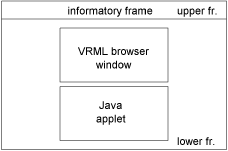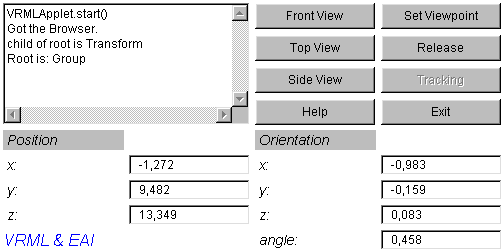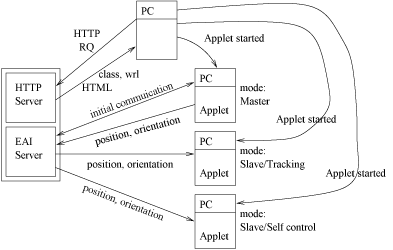Remote VRML browser control using EAI
Milan Kubec, Jiri Zara
Departament of Computer Science and Engeneering
Czech Technical University
Prague / Czech Republic
Content
Abstract
1 Introduction
2 External Authoring Interface for VRML
2.1 Access methods
2.2 Access to nodes
2.3 Sending events
2.4 Reading events
2.5 Being notified
3. Applet implementation
3.1 Security restrictions
3.2 Applet modes
3.2.1 Changing modes
3.3 Applet GUI and control
3.4 Getting and sending parameters
3.5 Users motion in the scene
3.6 Applet in HTML page
4 Server implementation
4.1 Establishing connection
4.2 During forwarding
4.3 Disconnecting
5 Details
5.1 Mandatory content of *.wrl file
5.2 Implementation and compilation
6 Problems & Future work
7 Conclusion
References
Abstract
The paper describes an implementation of experimental system, which
allows multiple users to cooperate within one VRML world. The program is
built up on architecture client/server. A Java applet is used for
communication between several users connected by a network. The applet
uses the External Authoring Interface (EAI) to influence/control a
VRML world in a browser embeded in a HTML page.
Keywords: VRML, EAI, Java, Applet, client/server
1 Introduction
Recently we can hear words "collaborative systems" very often. It
is such a system, where multiple users are engaged in particular shared
activity, usually from remote locations. This kind of cooperation is
very useful, e.g. two or more people in distant locations are able to
develop or consult their work without travelling and wasting
time and money. Up to now this kind of systems are mainly textually or 2D
(drawings) oriented. Another approach is to allow users to share
interaction in 3D. VRML and platform independent programming language
Java were chosen to achieve this goal. The internet provides the
communication background.
The aim of this project was to find out the way, how to remotely
control VRML browser and particular parameters of the VRML scene,
because it plays the main role in such collaborative systems.
The structure of this paper is organized as follows. The External
Authoring Interface is discussed in Chapter 2. The implementation of
the experimental system is described in two following sections. Applet
implementation in Chapter 3 and server implementation in Chapter 4.
Implementation details are described in Chapter 5. The last two chapters
contain discussion on the future work and conclusion.
2 External Authoring Interface for VRML
EAI [3] defines an interface between a VRML world and an external
environment. It contains a set of functions of the VRML browser that the
external program can call to affect (or get parameters from) the
VRML world. This contribution deals only with interface between a Java applet
on a HTML page and a VRML world opened in a viewer embeded in the same
page. There are some other interfaces such as COM or IPC based.
2.1 Access methods
EAI uses the existing VRML event model to access nodes in the scene.
This model is based on sending and receiving events (eventOuts,
eventIns). We can use four methods of accessing VRML worlds:
- accessing the functionality of the Browser Script Interface
[5], which is used by built-in script nodes. These functions provide a
mechanism to get or set browser state. Functions such as getName(),
getCurrentSpeed(), loadURL(), createVrmlFromURL(), addRoute() are available.
- sending events to eventIns of named nodes inside the scene.
- reading the last value sent from eventOuts of named nodes inside the
scene.
- getting notified when events are sent from eventOuts of named nodes
inside the scene.
The first three access methods are conceptually identical to Script Authoring
Interface, as described in ISO Standard [5]. The only difference is the way
of obtaining the reference to a node through which its eventIns and eventOuts
can be accessed. A script node can get a pointer to a node defined by DEF
and USE statements (called instancing). An applet has no access to instancing
mechanism, it has just a method to get the pointer to a node defined by DEF
statement only.
The last access overcomes the problem, that ROUTE statement cannot be
used for sending events from VRML scene to an applet. The applet has to
implement a registered method which is to be called when specified eventOut
occurs (i.e, callback mechanism).
2.2 Access to nodes
Only nodes, which are named using VRML statement DEF can be accessed by
an applet. Once the pointer to a node is obtained, it's easy to access all
eventOuts, eventIns and exposedFields of the node.
An instance of class Node can be obtained by function getNode() of
the class Browser. This instance is used to get access to desired
fields of the node. Calling getEventIn() method of class Node returns EventIn object,
when passed appropriate event name. The method getEventOut() returns an
EventOut object when passed event name. Also exposedFields can be
accessed either by passing name of exposedField itself (e.g., rotation),
or by passing name of corresponding event (e.g., set_rotation for
eventIn or rotation_changed for eventOut).
2.3 Sending events
Once an instance of EventIn class is obtained, an event can be sent to it.
EventIn is abstract class so the cast to appropriate EventIn subclass is
needed. This subclass contains a method for sending events of given
type. If a VRML scene contains the folowing node:
DEF SCALER Transform { ... }
the scale can be set to values (1.0, 2.5, 1.0) from applet like this:
Node scaler = browser.getNode("SCALER");
EventInSFVec3f scale =
(EventInSFVec3f) scaler.getEventIn("set_scale");
float sc[3] = { 1.0, 2.5, 1.0 };
scale.setValue(sc);
2.4 Reading events
Once an instance of EventOut is obtained, a value of event or
exposedField can be read. Since EventOut is abstract class it
needs a cast to appropriate subclass which contains method for
getting events of given type. Current value of scale field can be
read like this:
EventOutSFVec3f scale =
(EventOutSFVec3f) scaler.getEventOut("scale_changed");
float current_sc[3] = scale.getValue();
2.5 Being notified
Another feature of EAI is to be notified when an EventOut is generated
from the scene. In this case the applet must subclass the
EventOutObserver class, and implement callback() method.
The advice() method of EventOut is then passed the EventOutObserver.
Whenever an event is generated for that eventOut the callback() method
is invoked and passed the value and timestamp of the event. The
advise() method is also passed a user defined object. The value of this
object is passed to the callback() method and can be used by programmer
to pass user defined data to callback. It allows to handle events from
multiple sources, the source is distinguished just according to this value.
The following example shows how applet is notified when position
field of ProximitySensor is changed:
public class VRMLApplet implements EventOutObserver {
public void callback(EventOut event,
double timestamp, Object userdata) {
// process new values of event with respect to userdata
// userdata helps to distinguish among events
}
sensor = browser.getNode("PROXIMITY");
position = (EventOutSFVec3f)
sensor.getEventOutSFVec3f("position_changed");
position.advise(this, new Integer(1));
// number (1) is passed to callback method as userdata parameter
}
3. Applet implementation
The applet has to be placed into the same HTML page where the VRML browser
window is, it is the only way how external program can communicate with an
embeded VRML world. The applet provides interaction with user,
communication with VRML scene and network communication with server.
HTML page is divided into two frames, there is identification of applet
mode (described later) in upper frame. VRML world together with applet are located
in lower frame.

Fig 1.: HTML page layout
3.1 Security restrictions
Applets by default cannot execute certain kinds of tasks from security
reasons. Networking issues belongs to this kind of task too. Applet is not
allowed to make a connection to computer other than it came from.
To work around this restrictions we have used a client/server [2] model.
The server runs on the same computer, which
applet came from. All executed applets connect themselves to this server and then their
mutual communication is possible. This approach has some drawbacks,
two mains are: communication is slower than it would be among directly
connected applets, and the server must be invoked before applet communication
starts.
3.2 Applet modes
Due to different kinds of actions performed by applet, we divide operations
of applet into modes in our implementation. The first mode is called Master, in this
mode a user controls the world and all other participants can watch his/her
activity, there is no limitation on user's actions. All actions
(movements) are sent to server and then forwarded to all participants.
The other mode called Slave enable user either to watch actions
of Master (submode called Tracking) or to work with VRML
scene locally and independently (submode called Self control). No actions
are sent to server. There is one limitation, when user watches actions of
Master in submode Tracking, no interaction with VRML scene
is allowed. The reason will be explained in section Problems & Future
work. Upper frame shows current mode and submode.
Titles can be: Master, Slave/Self control or
Slave/Tracking.
3.2.1 Changing modes
Switching between applet modes is ensured by applet GUI. A user can change
Master mode only by clicking Release button. Then mode is changed
to Slave/Self control and the mode of next connected participant
(chosen by cyclic shift) is changed to Master. Then server
listens to this new Master and sends recieved messages to other participants.
This is the only way how a participant can get control of VRML world.
Once the applet is in Slave mode a user can switch between
Self control mode and Tracking mode (Self control button
or Tracking button).
3.3 Applet GUI and control
Applet GUI consist of window for informing users about actions performed
by applet. Then user has buttons to control applet. Buttons Front
View, Top View and Side View sets defined Viewpoints in
scene. Button Set Viewpoint adds current view as new
Viewpoint to scene (then user can set this Viewpoint using VRML browser
GUI). Clicking on button Release disconnect applet from server
and causes changing applet mode to Slave/Self control. Button
Tracking is active only in mode Slave, clicking this button
causes changing mode to Slave/Tracking and disables all GUI
elements for controling scene (even in VRML browser). Title of button is
changed to Self control, then clicking it causes changing mode to
Slave/Self control and enables back control GUI elements.
Functions of Help and Exit buttons are obvious from their
names. Exit button is enabled only in mode Master, because
server listens only to applet in this mode.

Fig 2.: Applet GUI
Text fields under text area and buttons informs user about current
position and orientation of view. This works in all modes and submodes.
3.4 Getting and sending parameters
Parameters of position and orientation are sent from Master applet
to server to be forwarded to all participants. Applet gets these
parameters from ProximitySensor (see section 5.1) by implementing
EventOutObserver interface and its method
callback(). Method advice() is called by two eventOuts:
position and orientation.
Applet doesn't send all new parameters immediately, but only when
accumulative chages of their values exceed certain thresholds.
3.5 Users motion in the scene
When a user tracks actions of Master applet in
Slave/Tracking mode, all recieved parameters of position and orientation from
server are set to current Viewpoint. This Viewpoint has empty
description field to be invisible in browser's list of Viewpoints
and it is bound to VRML browser when switching to Slave/Tracking
mode.
3.6 Applet in HTML page
The HTML file containing embeded wrl and class files has
one required semantic. Field MAYSCRIPT means that the applet can get
the VRML plugin browser object instatnce from the browser.
This method should be functional in Netscape Navigator and Internet
Explorer as well.
4 Server implementation
The server is intended to realize communication among applets. This is
by principle a multithreaded task, the server consists of three threads.
Server must run on the same computer which sends the applet and must be
invoked before establishing first connection.
4.1 Establishing connection
Main thread listens on defined socket, which is known to all applets.
When applet connects to this socket server stores its new socket number
into internal structure. After second applet connects and its socket number
is stored, two other threads are started. One thread which provides forwarding
messages from one applet to the others (this thread has maximal
priority). The other thread provides service of removing disconnected
applets sockets from internal structure of server.

Fig 3.: Establishing connection and forwarding
Server sends an order number to each new connected applet. From this
number the applet can decide if it should act like Master or
Slave applet.
4.2 During forwarding
Server forwards all recieved messages. When it recieves a message about
releasing Master mode. It hands over the control to next applet
(in cyclic order) and starts listening to this new Master applet
socket.
4.3 Disconnecting
Only applet which is currently in mode Master can be disconnected
and removed from server structures, because server listens only to this
applet. In this case the server sends message to next applet (in cyclic
order) that it become Master.
5 Details
5.1 Mandatory content of *.wrl file
Since the applet can access only nodes named by VRML statement DEF,
there are some mandatory named nodes required in base shared *.wrl file.
- NavigationInfo named INFO,
used for setting parameters of the scene, such as type of navigation or
speed of viewer.
- ViewPoints named FRONT_VIEW, TOP_VIEW, SIDE_VIEW,
these nodes are used by GUI of the applet, to help user navigate in the
scene. They should show the entire scene from front, top and side views.
- ViewPoint named SETTING_VIEWPOINT,
position and orientation are sent to this node in mode Tracking.
- ProximitySensor named PROXIMITY,
applet gets the position and orientation from this node, its bounding
box should cover whole scene.
- Group named ROOT,
main node for entire scene, all other nodes should be childrens of this
node. The node is necessary if programmer wants to access all nodes in
the scene.
5.2 Implementation and compilation
Both applet and server were implemented in language Java and compiled using
JDK 1.1.5 (because of support in web browsers). Java uses an environment
variable called CLASSPATH to look for classes. This variable
should be set to contain classes: vrml.external.Browser,
vrml.external.Node, vrml.external.field.*, vrml.external.exception.*.
These classes are usually stored in zip file in VRML browser home directory
(name of this file for VRML browser Cosmo Player is npcosmop211.zip or
npcosmop21.zip, depends on version). This implementation was tested only
on platform Windows using Netscape Navigator 4.07 and Cosmo Player 2.1.
6 Problems & Future work
We discover some problems during implementation of this system. The VRML
scene during setting parameters position and orientation
seemed to be jumping. It is caused by setting each of these parameters
separately. When the position is set, new orientation should be set immediately too, but
there is no function for setting more parameters at the time. Then there is
a moment when these parameters doesn't coresponds each other. This will
be solved by couple of functions called beginUpdate() and
endUpdate() from new proposal for EAI ISO Standart.
Another problem was with setting parameters for Viewpoint node in mode
Slave/Tracking, because if user moved with scene during tracking,
new position and orientation were added to current position of scene.
This was manifested like uncontroled moving of scene, until a new Viewpoint
was chosen from list. According to this all interaction with scene is
disabled in mode Slave/Tracking.
Using Back button and then Forward button on web browser
causes new start of applet and server adds to its structure a new
socket, but the last socket is still there. It means that if server
hands over to such unowned socked, communication stops.
There are many things to improve. Applets sends only information about
current viewer position and orientation. The system might send whole
VRML events to be more flexible. Then applet doesn't respond to closing
of web browser so server doesn't find out about exiting some applet,
this should be improved too. For real application of this system should
be worthy to think of another model of choosing next controling applet.
Another drawback is that there is fixed VRML file in HTML page, so users
cannot choose own scene.
7 Conclusion
Described implementation shows how to take advantage of Java applet and
VRML in different way than usual. Remote control of VRML world is
very interesting issue. It can be used in many different tasks.
Currently the system doesn't work like real collaborative system. It
allows users very few functions to perform. Only one user at time can
actualy work with a VRML scene. The other participants just watch and wait to
be chosen. On the other hand, the implementation provides good working
basis for future extensions of Java platform and VRML cooperation.
References
- [1] Flanagan, D.: Java in Nutshell, A desktop quick
reference - Java 1.1, Second edition, O'Reilly, 1997.
- [2] Java Tutorial, Sun Microsystems, 1998.
http://java.sun.com/docs/books/tutorial/
- [3] Marin, Ch.: Proposal for a VRML 2.0 informative
annex, External Authoring Interface, Silicon Graphics Inc., 1997.
http://cosmosoftware.com/products/player/developer/eai/
- [4] Aktihanoglu, M.: VRML 2.0 EAI FAQ, 1998.
http://members.xoom.com/muratak/eaifaq.html
- [5] VRML 97 Specification
http://www.vrml.org/Specifications/VRML97/
- [6] Hartman, J., Wernecke, J.: The VRML 2.0 Handbook -
building moving worlds on the web., Silicon Graphics Inc., Addison
Wesley, 1996.



